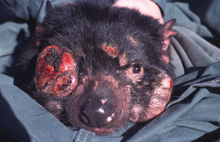Neoplasm
Appearance


A neoplasm is tissue that is growing where it should not be. If they become a mass, they become a tumour. Tumours are either malignant (harmful) or benign (safe). Cancer, for example is malignant and sometimes spreads to other places on the body. Some tumours have a cause that makes them grow. For some tumours no cause is known.[1][2][3] A tumour usually forms as a lump or mass.[4]
Tumours can occur in humans and animals. In humans, tumors can occur because the genetic code of cells is modified too much, causing affected cells to divide and expand uncontrollably.[5] The Tasmanian Devils in Tasmania, Australia are in danger of becoming extinct because of a malignant tumour that grows on their face.[6]
References
[change | change source]- ↑ "Type-2 pericytes participate in normal and tumoral angiogenesis". American Journal of Physiology. Cell Physiology. 307 (1): C25-38. Jul 2014. doi:10.1152/ajpcell.00084.2014. PMC 4080181. PMID 24788248.
{{cite journal}}: Unknown parameter|authors=ignored (help) - ↑ Cooper GM (1992). Elements of human cancer. Boston: Jones and Bartlett Publishers. p. 16. ISBN 978-0-86720-191-8.
- ↑ Taylor, Elizabeth J. (2000). Dorland's Illustrated medical dictionary (29th ed.). Philadelphia: Saunders. p. 1184. ISBN 0721662544.
- ↑ Stedman's medical dictionary (28th ed.). Philadelphia: Lippincott Williams & Wilkins. 2006. p. Neoplasm. ISBN 0781733901.
- ↑ Tammela, Tuomas; Sage, Julien (2020). "Investigating Tumor Heterogeneity in Mouse Models". Annual Review of Cancer Biology. 4 (1): 99–119. doi:10.1146/annurev-cancerbio-030419-033413. PMC 8218894. PMID 34164589.
- ↑ Department of Primary Industry and Water.[permanent dead link] Tasmanian Devil Facial Tumour Disease